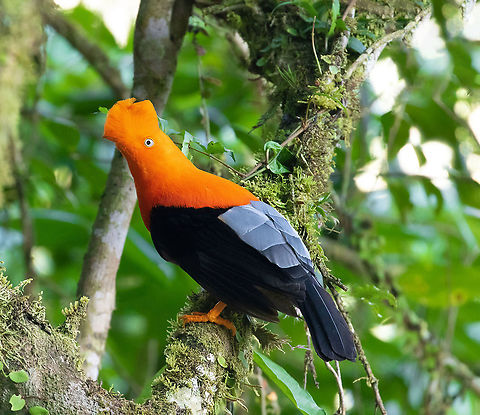
The Andean cock-of-the-rock is a medium-sized passerine bird of the Cotinga family native to Andean cloud forests in South America. It is widely regarded as the national bird of Peru. It has four subspecies and its closest relative is the Guianan cock-of-the-rock.
Similar species: Perching Birds
By Thibaud Aronson
All rights reserved
Uploaded Nov 23, 2020. Captured Jul 15, 2020 07:58 in 5NA, Peru.


comments (18)
What an absolute gem of a bird this is.
(Note that this subspecies is much more orange than the birds Ferdy photographed in Colombia, which are crimson.) Posted 5 years ago, modified 5 years ago
When we had our close encounter, I even had the feeling the frontal males were trying to out-compete me in silliness. On a second place we saw them, a more wild place, they were also the first thing we heard in the morning, yet always high up.
Congrats on the find. The orange sub species is really cool! Posted 5 years ago
Niel Posted 5 years ago
The male Andean Cock-of-the-Rock (Rupicola peruvianus) is certainly the avian heartthrob of the South American cloud forests! Like many birds, this species exhibits major sexual dimorphism. Males have brilliant plumage and a large crest on their heads, which practically engulfs their entire face. In comparison, the females are drab, brownish-orange, and are nearly invisible in the dense forest foliage.
Known as “Tunki” in the Quechua language, the Cock-of-the-Rock is the national bird of Peru! Before anyone jumps to conclusions about the origin of its common name, the Cock-of-the-Rock gets its name from its tendency to build nests on rocks and ledges. But, I’m sure that’s what you all were assuming…
The flamboyant appearance of the males, combined with their spectacular mating displays, is sure to set any female’s heart aflutter. Here’s how it goes: to impress potential mates, males gather in a lek at dawn and compete with each other by emitting unique mating calls, bobbing, hopping, and displaying their colorful plumage. If a female approaches, the males get even more rambunctious. Truly a spectacular sight to behold!
Cock-of-the-Rocks are mostly frugivorous, meaning they eat lots of fruit. But, they don’t digest the seeds. The seeds pass through their digestive systems unharmed. The birds defecate and regurgitate the seeds, sometimes at considerable distances from the parent trees. In this way, the Cock-of-the-Rock plays an important role in seed dispersal. {Spotted in Peru by JungleDragon moderator, Thibaud Aronson} #JungleDragon #Andeancockoftherock #Rupicolaperuvianus
Check out more of Thibaud's photos, which truly span the globe! He truly has a knack for finding exceptional creatures wherever he goes: https://www.jungledragon.com/user/2959/popular
https://www.facebook.com/jungledragonwildlife Posted 5 years ago
Happy New Year! To say that 2020 was a challenging year would be an understatement. But, it was not without beauty or inspiration. During 2020, the JungleDragon community uploaded more than 17,000 photos and over 3,700 new species to the website!
Thank you to all of our members and supporters for your passion, dedication to nature and photography, and encouragement! You make JungleDragon special, and we appreciate you!
We are excited to continue sharing, inspiring, and learning about nature together with you in 2021! We wish you all the best for the upcoming year!!
Here are ten of the most popular photos shared on JungleDragon during 2020! Enjoy!! {See photos for credits} #JungleDragon #Nature #2020
https://www.facebook.com/jungledragonwildlife Posted 4 years ago